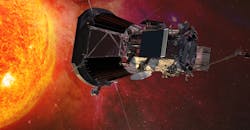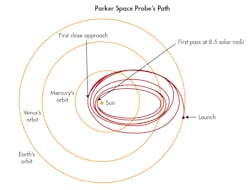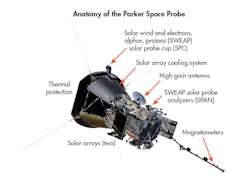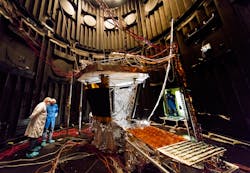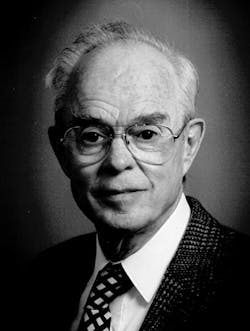NASA Preps Probe for Mission to the Sun
NASA technicians and engineers are putting the finishing touches on the Parker Solar Probe, a 9-ft., 10-in.-tall, 1,350-lb. spacecraft that will take off sometime between July 31 and Aug 19 of next year on a 6.9-year mission to explore the sun. The probe will be sent on it way atop a second stage mounted on a Delta IV heavy Lifter. It will go into a fairly eccentric elliptical orbit around the sun (see figure below). It will orbit the sun 24 times, and on seven of them will make flybys of Venus to increase its speed and tighten its orbit. The last orbit around the sun will take only 88 days travelling at up to 450,000 mph.
The probe will carry instruments to study magnetic fields, plasma and other energetic particles; it will also image the solar wind, a stream of ionized gases that stream through the solar system at more than a million mph. The probe’s three major scientific objectives are to:
Trace the flow of energy that heats and accelerates the solar corona and solar wind.
Determine the structure and dynamics of the plasma and magnetic fields that are the sources of the solar wind.
Explore mechanisms that accelerate and transport energetic particles.
All this requires that the probe fly as close as 3.9 million miles away from the sun, where temperatures reach nearly 2,500°F. A pair of solar arrays will provide electricity to power the probe’s instruments. One benefit of flying close to the sun is that the arrays will be receiving 25 times the solar energy they would get if in Earth’s orbit.
The major challenge in building the Parker Probe was to ensure that it won’t be incapacitated by the heat and radiation it encounters as it flies close to the sun. The probe also has to survive being dunked into that soup of heat and radiation close to the sun repeatedly, cooling off in between times on the 22 orbits.
The primary bulwark against the heat is the Thermal Protection System, an 8-ft.-diameter, 4.5-in.-thick heat shield made of carbon composites that will protect most of the spacecraft’s components from the full brunt of the heat—up to 2,500°F. It is imperative that the probe maneuvers and changes its attitude to keep the TPS between the sun and the probe’s internal components. But the nine-minute lag between when radio messages on position and speed are sent and received at controllers on Earth—and another nine minutes for the adjustments to be radioed back—meant that engineers had to make the Parker as autonomous as possible and able to maneuver on its own to keep the TP correctly positioned. This makes the probe one of the most autonomous spacecraft ever built by NASA.
The other major source of thermal protection will be the complex liquid cooling subsystem. Its main goal is protecting the solar arrays, the parts of the probe that will be exposed to the sun at most times. So NASA applied some lessons learned from its Messenger space probe used to explore Mercury from 2011 to 2015; specifically, NASA learned how to limit the degradation of solar panels due to UV light. Underneath the standard glass cover on Parker’s arrays, a ceramic carrier is soldered to the bottom of each photovoltaic cell. Each carrier is attached to a platen with a thermally-conductive adhesive to let heat move out of the arrays and into the cooling water easily, all the while maintaining electrical insulation between cells.
The probe will also use its autonomous capabilities to keep the adjustable solar arrays or wings as shielded as possible, but still exposed enough to generate power when needed. This is critical: NASA estimates that at some times during the probe’s mission, a change of only one degree in the solar arrays’ wing angles would call for a 35% increase in the liquid cooling subsystem’s output.
Analysis determined this subsystem would need a working fluid that would remain liquid from 50° to 257°F (10° to 125°C). The best choice was pressurized water; pressurization raises its boiling point to above 257°. The five liters of water the craft carries will also be deionized so that nothing in the water will gum up the plumbing.
Prior to launch, the water will be stored in a heated accumulator to ensure it does not freeze during the initial phase of the mission. But an hour into the mission, the probe separates from the launch vehicle. The warm water is pushed into two of the subsystem’s four radiators and the by-now deployed solar arrays using one of the craft’s two-speed pumps. The radiators consists of titanium tubes that won’t corrode covered with aluminum cooling fins just two-hundredths of an inch thick. The radiators are blanketed against thermal losses to prevent any water from freezing during early phases of the mission. At nominal operating capacity, this cooling subsystem provides 6,000 W of cooling.
With the solar arrays proving electricity to charge the batteries, the probe begins its initial approach to the sun—a 40-day trip. At the end of that portion of the journey, water for the two dormant radiators is released and the two radiators put into action. The water-based cooling subsystem should keep the arrays at 320°F or below.
The Man Behind the Probe’s Name
NASA initially named the spacecraft the Solar Probe Plus spacecraft, but they quickly rechristened it the Parker Solar Probe in honor of Eugene Parker. In 1958, Parker—then a young astrophysicist at the University of Chicago—published a paper called “Dynamics of the Interplanetary Gas and Magnetic Fields.” Parker believed there was high-speed matter and magnetism constantly escaping the sun, and that it affected the planets and space throughout our solar system. This phenomenon, now known as the solar wind, has been proven through repeated observations.
In the 1950s, Parker also proposed a number of concepts about how stars, including our sun, give off energy. He termed this cascade of energy the solar wind, and he described an entire complex system of plasmas, magnetic fields, and energetic particles that make up this phenomenon. Parker also theorized an explanation for the superheated solar atmosphere, the corona, which is—contrary to what was expected by physics laws—hotter than the surface of the sun itself. Many NASA missions have continued to focus on this complex space environment defined by our star, a field of research known as heliophysics.
This is the first time NASA has named a spacecraft for a living individual. “It’s a testament to the importance of his body of work, founding a new field of science that inspired many important science questions NASA continues to study and further understand every day,” says Thomas Zurbuchen, an associate administrator at NASA.
Born on June 10, 1927, in Michigan, Eugene Newman Parker earned a Bachelor of Science in physics from Michigan State University and a doctorate from Caltech. He then taught at the University of Utah, and since 1955, has held faculty positions at the University of Chicago and at its Fermi Institute. Parker has received numerous awards for his research, including the George Ellery Hale Prize, the National Medal of Science, the Bruce Medal, the Gold Medal of the Royal Astronomical Society, the Kyoto Prize, and the James Clerk Maxwell Prize.
